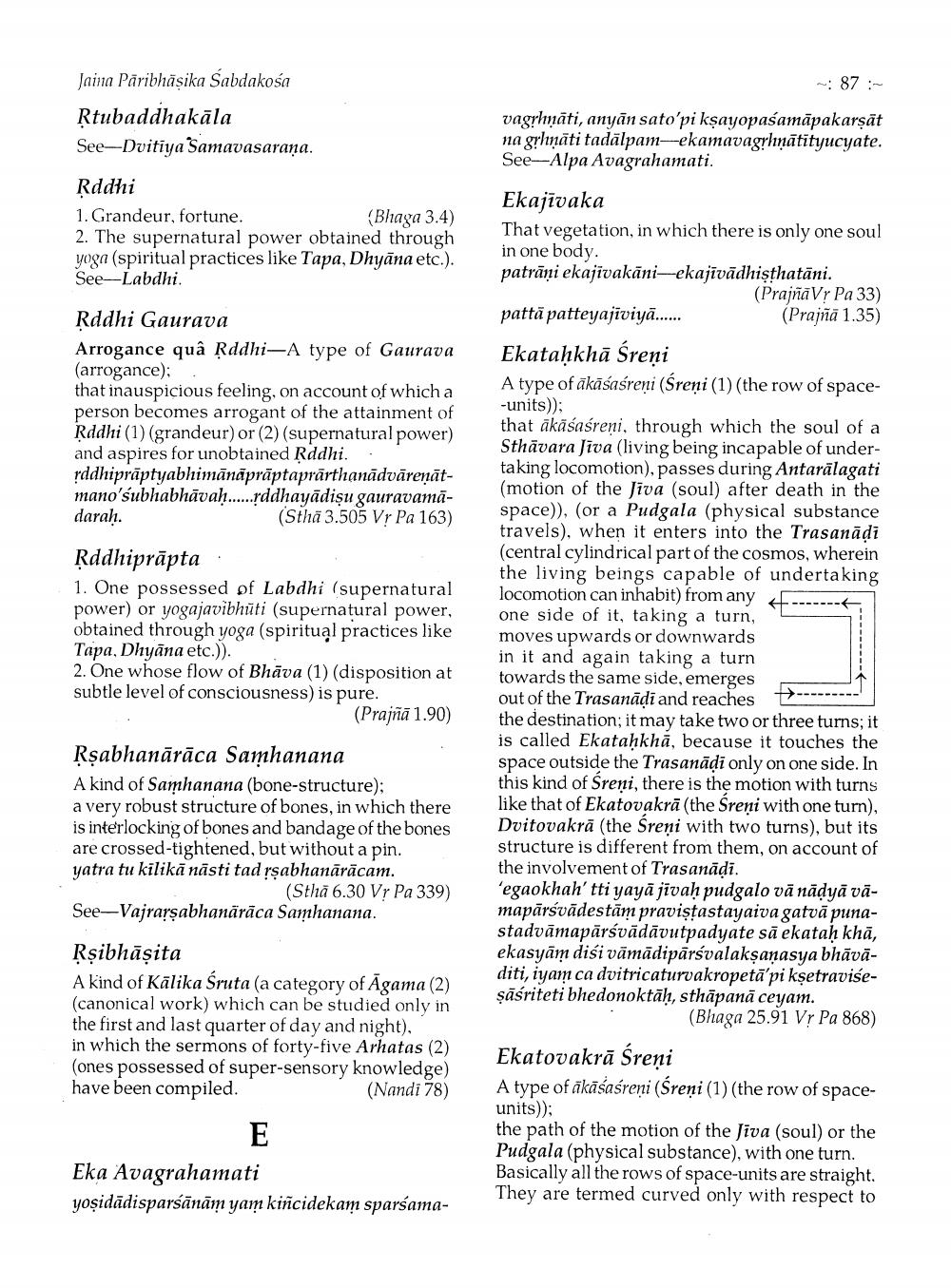________________
: 87 :
vagyhņāti, anyān sato'pi kşayopasamāpakarşāt na grlnäti tadälpamekamavagylınātityucyate. See-Alpa Avagrahamati.
Jaina Pāribhāsika Sabdakośa Rtubaddhakāla See-Dvitiya Samavasarana. Rddhi 1. Grandeur, fortune.
(Bhaga 3.4) 2. The supernatural power obtained through yoga (spiritual practices like Tapa, Dhyāna etc.). See-Labdhi.
Rddhi Gaurava Arrogance quâ Rddhi-A type of Gaurava (arrogance); that inauspicious feeling, on account of which a person becomes arrogant of the attainment of Rddhi (1) (grandeur) or (2) (supernatural power) and aspires for unobtained Rddhi.. rddhiprāptyabhimānāprāptaprārthanādvāreņātmano'śubhabhāvah......rddhayādişu gauravamadarah.
(SNhã 3.505 VỊ Pa 163)
Rddhiprāpta 1. One possessed of Labdhi (supernatural power) or yogajavibhuti (supernatural power, obtained through yoga (spiritual practices like Tapa, Dhyāna etc.)). 2. One whose flow of Bhāva (1) (disposition at subtle level of consciousness) is pure.
(Prajna 1.90)
Ekajīvaka That vegetation, in which there is only one soul in one body. patrāņi ekajivakāni-ekajīvādhişthatäni.
(PrajnaVr Pa 33) pattā patteyajiviyā......
(Prajmã 1.35) Ekataḥkhā Śreņi A type of ākāśaśreni (Śreņi (1) (the row of space-units)); that ākāśaśreņi, through which the soul of a Sthāvara Jiva (living being incapable of undertaking locomotion), passes during Antarālagati (motion of the Jiva (soul) after death in the space)), (or a Pudgala (physical substance travels), when it enters into the Trasanādi (central cylindrical part of the cosmos, wherein the living beings capable of undertaking locomotion can inhabit) from any one side of it, taking a turn, moves upwards or downwards in it and again taking a turn towards the same side, emerges out of the Trasanādi and reaches →
---- the destination; it may take two or three turns; it is called Ekataḥkhā, because it touches the space outside the Trasanādi only on one side. In this kind of Sreni, there is the motion with turns like that of Ekatovakrā (the Sreni with one turn), Dvitovakrā (the Sreni with two turns), but its structure is different from them, on account of the involvement of Trasanādi. 'egaokhah'tti yayā jīvah pudgalo vā nädyā vāmapārsvādestām praviştastayaiva gatvā punastadvāmаpārsvādāvutpadyate sā ekatah khā, ekasyām disi vāmādipārsvalaksanasya bhāvāditi, iyam ca dvitricaturvakropeta'pi kşetraviseşāśriteti bhedonoktāḥ, sthāpanā ceyam.
(Bhaga 25.91 Vr Pa 868)
Rşabhanārāca Samhanana A kind of Samhanana (bone-structure); a very robust structure of bones, in which there is interlocking of bones and bandage of the bones are crossed-tightened, but without a pin. yatra tu kilikā nāsti tad rşabhanārācam.
(Sthā 6.30 Vr Pa 339) See-Vajrarṣabhanārāca Samhanana.
Rşibhāṣita A kind of Kālika Śruta (a category of Agama (2) (canonical work) which can be studied only in the first and last quarter of day and night), in which the sermons of forty-five Arhatas (2) (ones possessed of super-sensory knowledge) have been compiled.
(Nandi 78)
A
Ekatovakrā Śreņi A type of äkāšaśreni (Śreni (1) (the row of spaceunits)); the path of the motion of the Jiva (soul) or the Pudgala (physical substance), with one turn. Basically all the rows of space-units are straight. They are termed curved only with respect to
Eka Avagrahamati yoșidādisparśānām yam kiñcidekam sparsama




